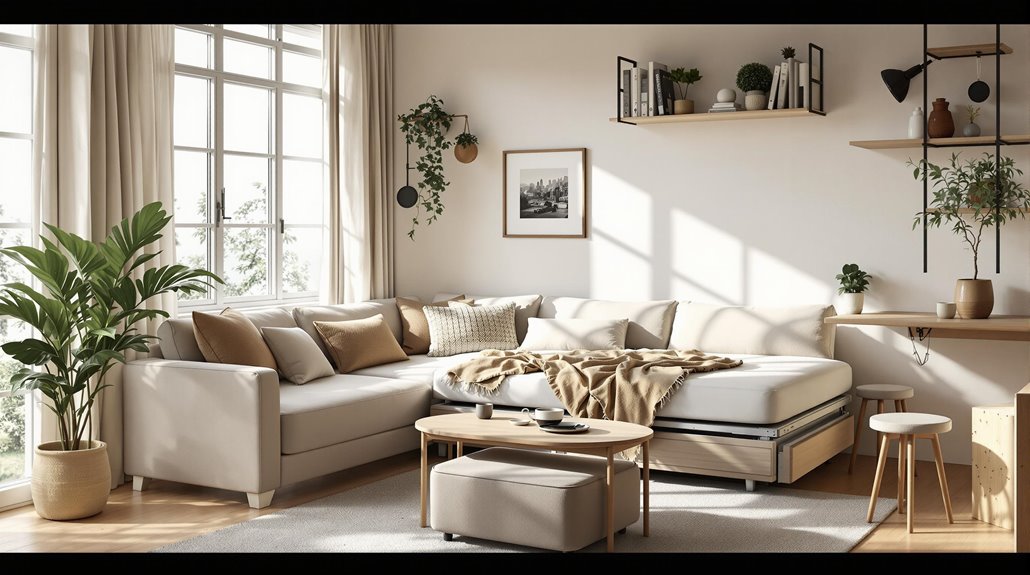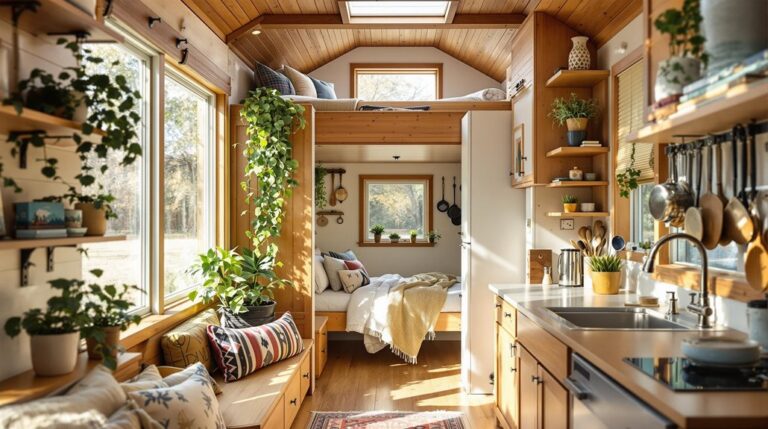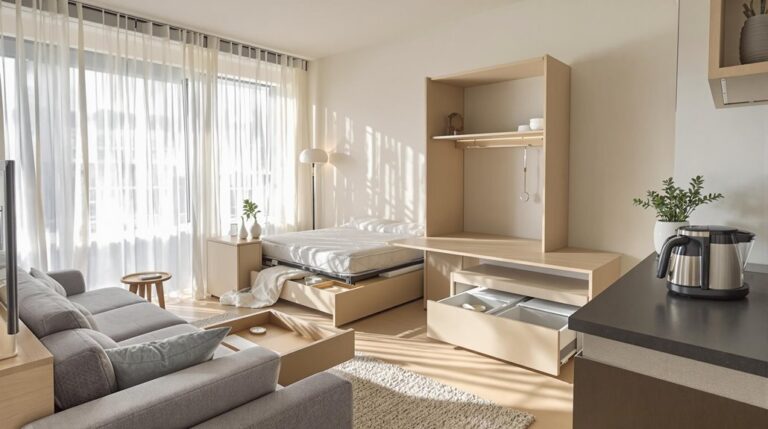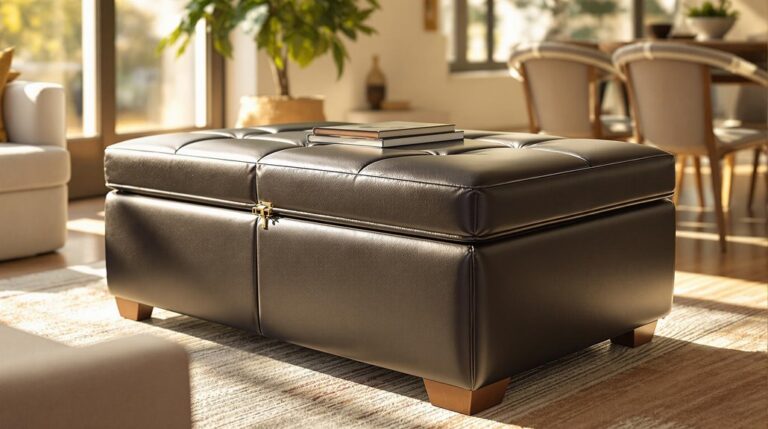Modern homeowners face unique challenges when furnishing compact living spaces. The living room, often the heart of daily activities, requires thoughtful design that balances functionality with comfort. Today’s innovative furniture solutions address these constraints through clever engineering and adaptable features. From wall-mounted storage to modular seating arrangements, these space-conscious options transform limited square footage into inviting environments. The intersection of design ingenuity and practical living awaits those seeking to maximize their small but mighty living rooms.
Key Takeaways
- Multifunctional furniture like sofas with built-in storage maximizes space while maintaining comfort and style.
- Light-colored walls and strategic mirror placement create visual spaciousness and enhance natural illumination.
- Modular sectionals offer flexible configurations that adapt to different activities and social gatherings.
- Vertical storage solutions utilize wall space effectively while keeping floors clear for movement.
- Smart technology integration enables customizable lighting and temperature for optimal comfort in compact spaces.
The Rise of Multifunctional Furniture in Modern Living

As urbanization accelerates in emerging economies and living spaces continue to shrink in metropolitan areas worldwide, multifunctional furniture has emerged as a practical solution for modern living rooms.
The global market, valued at $12.8 billion in 2023, reflects growing consumer demand for space-efficient designs that serve multiple purposes.
These versatile pieces offer multifunctional benefits that extend beyond space-saving, incorporating sustainability principles through resource-efficient construction.
Current design trends emphasize lightweight materials like engineered wood and metal alloys that enable easy transformation while maintaining durability in high-traffic living areas.
Smart technology integration further enhances functionality with built-in charging stations and IoT-enabled storage solutions.
As minimalist lifestyles gain popularity, furniture that seamlessly integrates multiple functions—such as sofa beds, convertible tables, and modular systems—continues to dominate the market, particularly in urban homes where versatility outweighs traditional single-purpose designs.
Space-Saving Storage Solutions That Don’t Sacrifice Style
Nearly every homeowner with limited square footage faces the challenge of balancing storage needs with aesthetic appeal.
Fortunately, contemporary design offers numerous options that maintain hidden storage while achieving aesthetic balance in compact living rooms.
Built-in shelving systems that extend floor-to-ceiling maximize vertical space while providing dedicated zones for books, decor, and concealed items.
For flexible solutions, consider multi-compartment furniture like storage ottomans or benches that double as seating while housing linens or accessories.
Wall-mounted shelving creates streamlined storage without consuming valuable floor space, while decorative baskets corral everyday items in plain sight yet organized fashion.
Glass-front cabinets and backless shelving units minimize visual heaviness while showcasing select pieces.
For truly versatile options, modular systems with interchangeable components adapt to evolving storage requirements without compromising style.
Modular Designs: Transforming Rooms for Various Needs

Modular furniture represents the ultimate solution for small-space dwellers seeking versatility without sacrificing style or comfort.
These transformative pieces adapt to changing needs through flexible configurations, allowing sectionals to shift from L-shaped corner arrangements to conversation circles as required.
The brilliance of modular transformations lies in their multifunctionality—adjustable backrests support various postures while integrated console sections eliminate the need for additional tables.
Many designs feature hidden storage compartments that maintain clutter-free zones, essential in compact living areas. Open-leg designs maintain visual lightness, while monochromatic color schemes create seamless visual flow.
When positioned strategically, sectional components can even serve as effective room dividers in open-concept spaces, delineating functional areas without the permanence of walls—perfect for homes where square footage demands maximum efficiency.
Sustainable Materials for Compact Living Environments
Sustainability stands at the forefront of modern interior design, particularly for those maneuvering compact living environments where every material choice carries amplified importance. Reclaimed wood from demolished structures offers character while reducing timber waste, complemented perfectly by eco-friendly finishes like low-VOC paints that maintain healthy indoor air quality.
Small spaces benefit tremendously from sustainable textiles such as wool insulation, which provides natural temperature regulation while occupying minimal wall thickness. Bamboo flooring presents a renewable alternative to traditional hardwoods, offering durability without excessive environmental impact.
For multifunctional living areas, composite materials made from recycled plastics and wood fibers create resilient surfaces that withstand daily use. Local sourcing further enhances sustainability by reducing transportation emissions while supporting community craftsmanship—proving that compact living can simultaneously honor both human comfort and environmental stewardship.
Vertical Thinking: Maximizing Wall Space in Small Living Rooms

Vertical space represents the most underutilized asset in compact living areas, offering substantial storage and display potential without encroaching on precious floor square footage.
Wall mounted shelves create eye-level accessibility for frequently used items while adding visual interest through layered organization. Floating options enhance elegance, while bracket shelves provide support for heavier decorative elements.
Elevate your space with wall-mounted shelving that combines practical storage with visual dimension and architectural interest.
For renters, hidden storage solutions using adhesive or tension-based fixtures offer non-permanent alternatives.
Interior cabinet shelving conceals small items, while over-door organizers maximize previously unused spaces. Combining pegboard strips with adjustable hooks accommodates varying item sizes and creates customizable systems that evolve with changing needs.
The integration of multipurpose furniture, such as fold-down desks or TV wall mounts, further eliminates bulky furnishings, allowing living rooms to maintain an open, uncluttered appearance while serving multiple functions.
Color and Light Strategies to Create Spacious Atmospheres
Beyond maximizing vertical space, the visual aspects of a room considerably influence its perceived size and comfort. Strategic color selection creates expansive atmospheres in compact living areas.
Cool tones like blues and greens promote relaxation while making walls appear to recede, whereas neutrals reflect light efficiently, reducing visual clutter.
For ideal spaciousness, consider monochromatic schemes that unify the space or color contrast techniques that define zones without overwhelming the eye.
Light layering is equally important—combine glossy ceiling finishes with translucent window treatments to maximize natural illumination.
Position light-colored furniture near windows to enhance light distribution, and incorporate metallic accents for subtle reflection.
Pairing high-reflectance neutrals with strategic dark accents adds depth without diminishing openness.
Even the smallest living rooms can feel airy and inviting with thoughtful color and light management.
Smart Furniture: Technology Integration for Small Spaces

As technology becomes increasingly integrated into daily life, smart furniture has emerged as a revolutionary solution for small-space living.
Modern furniture innovation combines functionality with smart technology, offering transformable pieces like IKEA’s UTÅKER that converts between beds and sofas for maximum flexibility. Wireless charging surfaces embedded in side tables eliminate cord clutter, while voice-controlled systems allow hands-free operation of beds that fold into walls or tables that adjust to different heights.
Smart furniture merges form and function, transforming limited spaces with adaptable, tech-integrated pieces for modern living needs.
For those with limited square footage, robotic furniture that automatically repositions creates temporary workspaces when needed.
Looking ahead, the integration of smart materials and AI-powered sensors promises furniture that adapts to residents’ habits, suggesting ideal configurations based on usage patterns and automatically adjusting to different activities throughout the day.
Frequently Asked Questions
How Do Minimalist Furniture Choices Affect Home Resale Value?
Minimalist aesthetics positively influence home resale value by creating visual appeal that attracts buyers seeking clean, uncluttered spaces.
Properties featuring streamlined furniture typically photograph better online and appear more spacious during viewings.
According to market trends, homes with thoughtfully curated minimalist interiors often sell faster and command higher prices, as they showcase versatility and modern design sensibilities that enhance resale potential across diverse buyer demographics.
What’s the Average Lifespan of Multifunctional Versus Traditional Living Room Furniture?
Traditional living room furniture typically outlasts multifunctional counterparts in durability comparison studies.
While standard sofas and chairs last 7-15 years, multifunctional pieces average 5-10 years due to mechanical stress on hinges, joints, and moving parts.
Usage frequency greatly impacts longevity; traditional pieces withstand regular use, while multifunctional items deteriorate faster with daily transformation.
Material quality affects both categories, with leather and solid wood frames extending lifespan regardless of furniture type.
How Do Furniture Rental Options Compare for Small-Space Living?
Furniture rental options offer significant benefits for small-space living through flexible, budget-friendly arrangements.
Subscribers access high-quality, multi-functional pieces without long-term commitment or storage concerns. Short-term rentals ($500-$1,200 monthly) often provide superior space-saving solutions compared to purchased alternatives.
Online platforms and subscription services have expanded accessibility, offering curated packages specifically designed for compact environments. This approach allows residents to adapt their living spaces seasonally without substantial investment.
Can Vintage Furniture Effectively Integrate Into Modern Small-Space Designs?
Vintage furniture integrates remarkably well into modern small-space designs through thoughtful adaptation.
Authentic vintage aesthetics contribute character while providing sustainable alternatives to mass-produced items. Their typically compact dimensions suit urban dwellings perfectly, while modular vintage pieces maximize functionality.
Modern integration succeeds when designers balance statement pieces with neutral elements, incorporate efficient storage solutions, and repurpose items to accommodate technology while preserving their historical charm.
Strategic placement prevents overcrowding while celebrating unique craftsmanship.
How Do Insurance Policies Cover Multifunctional Furniture Damage?
Furniture insurance for multifunctional pieces typically covers accidental damage like stains, mechanical failures, and surface damage.
However, most policies contain important exclusions such as intentional damage, wear and tear, and transit-related incidents.
Homeowners should carefully review coverage terms, as claims must typically be filed within 30 days of damage occurrence.
Protection plans generally last 2-5 years and may require specific documentation, proper installation, and maintenance to remain valid.
Bottom Line
Today’s small-space living rooms offer remarkable versatility through thoughtful design approaches. By selecting multifunctional furniture, implementing smart storage solutions, and embracing sustainable materials, homeowners can create comfortable, stylish environments regardless of square footage. Vertical organization and strategic color choices further enhance spatial perception, while integrated technology adds convenience without clutter. These combined strategies demonstrate that limited space need not limit comfort, functionality, or personal expression in modern homes.




